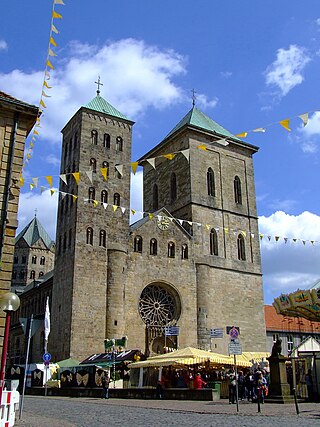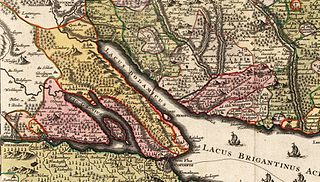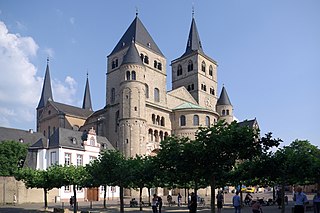
The Diocese of Mainz, historically known in English as Mentz as well as by its French name Mayence, is a Latin Church ecclesiastical territory or diocese of the Catholic Church in Germany. It was founded in 304, promoted in 780 to Metropolitan Archbishopric of Mainz and demoted back in 1802 to bishopric. The diocese is suffragan diocese in the ecclesiastical province of the metropolitan Archdiocese of Freiburg. Its district is located in the states of Rhineland-Palatinate and Hesse. The seat of the diocese is in Mainz at the Cathedral dedicated to Saints Martin and Stephen.

The Diocese of Passau is a Roman Catholic diocese in Germany that is a suffragan of the Archdiocese of Munich and Freising. Though similar in name to the Prince-Bishopric of Passau—an ecclesiastical principality that existed for centuries until it was secularized in 1803—the two are entirely different entities. The diocese covers an area of 5,442 km².

The Diocese of Chur is a Latin Church ecclesiastical territory or diocese of the Catholic Church in Switzerland. It extends over the Swiss Cantons of Graubünden (Grisons), Schwyz, Glarus, Zurich, Nidwalden, Obwalden and Uri.

The Archdiocese of Munich and Freising is an ecclesiastical territory or diocese of the Roman Catholic Church in Bavaria, Germany. It is governed by the Archbishop of Munich and Freising, who administers the see from the co-cathedral in Munich, the Frauenkirche, which is never called in German Munich Cathedral. The other, much older co-cathedral is Freising Cathedral.

The Diocese of Osnabrück is a Latin Church ecclesiastical territory or diocese of the Catholic church in Germany. The diocese was originally founded circa 800. It should not be confused with the smaller Prince-Bishopric of Osnabrück–an ecclesiastical principality of the Holy Roman Empire until 1803–over which the bishop, as prince-bishop, exercised both temporal and spiritual authority.

The Diocese of Halberstadt was a Roman Catholic diocese from 804 until 1648. From 1180, the bishops or administrators of Halberstadt ruled a state within the Holy Roman Empire, the prince-bishopric of Halberstadt. The diocesan seat and secular capital was Halberstadt in present-day Saxony-Anhalt.

The Diocese of Kotor is a Latin Church ecclesiastical jurisdiction or diocese of the Catholic Church in the Bay of Kotor and Municipality of Budva area in Montenegro. It is centered in the city of Kotor (Cattaro). It was erected as a diocese in the 10th century.

The Archdiocese of Paderborn is an archdiocese of the Latin Rite of the Roman Catholic Church in Germany; its seat is Paderborn. It was a diocese from its foundation in 799 until 1802, and again from 1821 until 1930. In 1930, it was promoted to an archdiocese. From 1281 until 1802, the Bishopric of Paderborn was also a state of the Holy Roman Empire.

The Diocese of Lebus is a former diocese of the Catholic Church. It was erected in 1125 and suppressed in 1598. The Bishop of Lebus was also, ex officio, the ruler of a lordship that was coextensive with the territory of the diocese. The geographic remit included areas that are today part of the land of Brandenburg in Germany and the Province of Lubusz in Poland. It included areas on both sides of the Oder River around the town of Lebus. The cathedral was built on the castle hill in Lubusz and was dedicated to St Adalbert of Prague. Later, the seat moved to Górzyca, back to Lebus and finally to Fürstenwalde on the River Spree.

The Prince-Bishopric of Constance, was a small ecclesiastical principality of the Holy Roman Empire from the mid-12th century until its secularisation in 1802–1803. In his dual capacity as prince and as bishop, the prince-bishop also governed the Diocese of Konstanz, which existed from about 585 until its dissolution in 1821, and whose territory extended over an area much larger than the principality. It belonged to the ecclesiastical province of Mainz since 780/782.

The Prince-Bishopric of Minden was an ecclesiastical principality of the Holy Roman Empire. It was progressively secularized following the Protestant Reformation when it came under the rule of Protestant rulers, and by the Peace of Westphalia of 1648 given to Brandenburg as the Principality of Minden. It must not be confused with the Roman Catholic diocese of Minden, which was larger, and over which the prince-bishop exercised spiritual authority.

The Roman Catholic Metropolitan Archdiocese of Santo Domingo is a Latin Metropolitan Archdiocese in the Dominican Republic. The see was erected 8 August 1511 as the Diocese of Santo Domingo and elevated to archdiocese on 12 February 1546.

The Roman Catholic Metropolitan Archdiocese of Ljubljana is an ecclesiastical territory or diocese of the Roman Catholic Church in Slovenia.

The Roman Catholic Diocese of Chełmno was a Roman Catholic diocese in Chełmno Land, founded in 1243 and disbanded in 1992.

The Diocese of Trier, in English historically also known as Treves from French Trèves, is a Latin Church ecclesiastical territory or diocese of the Catholic church in Germany. When it was the archbishopric and Electorate of Trier, it was one of the most important states of the Holy Roman Empire, both as an ecclesiastical principality and as a diocese of the church. Unlike the other Rhenish dioceses—including Mainz and Cologne–Trier was the former Roman provincial capital of Augusta Treverorum. Given its status, Trier has continuously been an episcopal see since Roman times and is one of the oldest dioceses in all of Germany. The diocese was elevated to an archdiocese in the time of Charlemagne and was the metropolitan for the dioceses of Metz, Toul, and Verdun. After the victory of Napoleon Bonaparte of France, the archdiocese was lowered to a diocese and is now a suffragan in the ecclesiastical province of the Archdiocese of Cologne. The diocesan cathedral is the Cathedral of Saint Peter. The Cathedral Chapter retains the right to elect the bishop, rather than selection by papal appointment.

The Roman Catholic Diocese of Włocławek, until the 20th century known as the Roman Catholic Diocese of Kujawy, is a suffragan diocese of the Latin Rite of the Roman Catholic Church in the Ecclesiastical province of the Metropolitan Roman Catholic Archdiocese of Gniezno in western Poland.

The Italian Roman Catholic Diocese of Trieste in the Triveneto, has existed since no later than 524, and in its current form since 1977. The bishop's seat is in Trieste Cathedral. It is a suffragan of the Archdiocese of Gorizia.
Ottaviano Maria Sforza (1475–1545) was a Roman Catholic prelate who served as Bishop of Arezzo (1519–1525), Bishop of Lodi, and Titular Patriarch of Alexandria (1541–1545) and Bishop of Terracina, Priverno e Sezze (1541–1545).


















